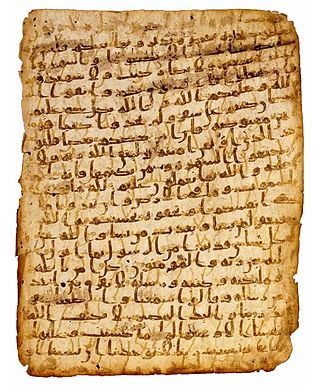
Allah is the common Arabic word for God. In the English language, the word generally refers to God in Islam. The word is thought to be derived by contraction from al-ilāh, which means "the god", and is linguistically related to the Aramaic words Elah and Syriac ܐܲܠܵܗܵܐ (ʼAlāhā) and the Hebrew word El (Elohim) for God.

The Bible is a collection of religious texts or scriptures, some, all, or a variant of which, are held to be sacred in Christianity, Judaism, Samaritanism, Islam, Baha'i'ism and many other religions. The Bible is an anthology, a compilation of texts of a variety of forms, originally written in Hebrew, Aramaic, and Koine Greek. These texts include instructions, stories, poetry, and prophecies, and other genres. The collection of materials that are accepted as part of the Bible by a particular religious tradition or community is called a biblical canon. Believers in the Bible generally consider it to be a product of divine inspiration, but the way they understand what that means and interpret the text varies.

The Gospel of Barnabas is a non-canonical, pseudepigraphical gospel written in the Late Middle Ages and attributed to the early Christian disciple Barnabas, who is one of the apostles of Jesus. It is about the same length as the four canonical gospels combined and largely harmonises stories in the canonical gospels with Islamic elements such as the denial of Jesus' crucifixion. The gospel presents a detailed account of the life of Jesus. It begins with the nativity of Jesus, which includes the annunciation by the archangel Gabriel to Mary which precedes Jesus' birth. The gospel follows his ministry, ending with the message of Jesus to spread his teachings around the world. Judas Iscariot replaced Jesus at the crucifixion.
Gospel originally meant the Christian message, but in the 2nd century it came to be used also for the books in which the message was reported. In this sense a gospel can be defined as a loose-knit, episodic narrative of the words and deeds of Jesus, culminating in his trial and death and concluding with various reports of his post-resurrection appearances. Modern biblical scholars are cautious of relying on the gospels uncritically, but nevertheless, they provide a good idea of the public career of Jesus, and critical study can attempt to distinguish the original ideas of Jesus from those of the later Christian authors.

The Gospel of James is a second-century infancy gospel telling of the miraculous conception of the Virgin Mary, her upbringing and marriage to Joseph, the journey of the couple to Bethlehem, the birth of Jesus, and events immediately following. It is the earliest surviving assertion of the perpetual virginity of Mary, meaning her virginity not just prior to the birth of Jesus, but during and afterwards, and despite being condemned by Pope Innocent I in 405 and rejected by the Gelasian Decree around 500, became a widely influential source for Mariology.
The New Testament (NT) is the second division of the Christian biblical canon. It discusses the teachings and person of Jesus, as well as events relating to first-century Christianity. The New Testament's background, the first division of the Christian Bible, is called the Old Testament, which is based primarily upon the Hebrew Bible; together they are regarded as sacred scripture by Christians.
Paraclete is a Christian biblical term occurring five times in the Johannine texts of the New Testament. In Christian theology, the word commonly refers to the Holy Spirit and is translated as 'advocate', 'counsellor' or 'helper'.

The Infancy Gospel of Thomas is an apocrypha gospel about the childhood of Jesus. The scholarly consensus dates it to the mid-to-late second century. The Infancy Gospel of Thomas is generally considered to be Gnostic in origin because of references in letters to a "Gospel of Thomas", but it is unclear whether those letters refer to the Infancy Gospel or the Gospel of Thomas, a sayings gospel discovered near Nag Hammadi, Egypt in 1945.

The New Testament apocrypha are a number of writings by early Christians that give accounts of Jesus and his teachings, the nature of God, or the teachings of his apostles and of their lives. Some of these writings were cited as scripture by early Christians, but since the fifth century a widespread consensus has emerged limiting the New Testament to the 27 books of the modern canon. Roman Catholic, Eastern Orthodox, and Protestant churches generally do not view the New Testament apocrypha as part of the Bible.
Injil is the Arabic name for the Gospel of Jesus (Isa). This Injil is described by the Quran as one of the four Islamic holy books which was revealed by God, the others being the Zabur, the Tawrat, and the Quran itself.
Taḥrīf is an Arabic-language term used by Sunni and Shia Muslims to refer to believed alterations made to the previous revelations of God—specifically those that make up the Tawrat, the Zabur and the Injil. It is also used to refer to what Muslims consider to be the corrupted Jewish and Christian interpretations of the previous revelations of God, known as “Tahrif al-Mana”. This concept holds that the previous revelations of God have been misinterpreted.

Islamic holy books are certain religious scriptures that are viewed by Muslims as having valid divine significance, in that they were authored by God (Allah) through a variety of prophets and messengers, including those who predate the Quran. Among the group of religious texts considered to be valid revelations, the three that are mentioned by name in the Quran are the Tawrat, received by prophets and messengers amongst the Children of Israel; the Zabur (Psalms), received by David; and the Gospel, received by Jesus. Additionally, the Quran mentions God's revealing of the Scrolls of Abraham and the Scrolls of Moses.
Arabic translations of the Bible constitute one of the richest traditions of Bible transmission. Translations of the Bible into Arabic were produced by Arabic-speaking Jews, Christians, and Samaritans. Even though Arabic was spoken by Jews and Christians before the advent of Islam, running Arabic translations of the Bible are attested in manuscripts only from the 9th century CE onwards. So far, no evidence could be adduced that Arabic Bible translations were available at that time. Before that, quotations from the Bible were used in Arabic especially by Christians.

Arguments that prophecies of Muhammad exist in the Bible have formed part of Islamic tradition since at least the mid-8th century, when the first extant arguments for the presence of predictions of Muhammad in the Bible were made by Ibn Ishaq in his Book of Military Expeditions. A number of Christians throughout history, such as John of Damascus and John Calvin, have interpreted Muhammad as being the Antichrist of the New Testament.
Among the books considered to be revealed by God in the Quran, the three mentioned by name are the Tawrat, the Arabic-language name for the Torah within its context as an Islamic holy book believed by Muslims to have been given by God to the prophets and messengers amongst the Children of Israel; the Zabur (Psalms) revealed to Dawud (David); and the Injil (Gospel) revealed to Isa (Jesus). The Quran mentions the Torah, Psalms, and Gospel as being revealed by God in the same way the Quran was revealed to Muhammad, the final prophet and messenger of God according to Muslims.
Prophets in Islam are individuals in Islam who are believed to spread God's message on Earth and to serve as models of ideal human behaviour. Some prophets are categorized as messengers, those who transmit divine revelation, most of them through the interaction of an angel. Muslims believe that many prophets existed, including many not mentioned in the Quran. The Quran states: "And for every community there is a messenger." Belief in the Islamic prophets is one of the six articles of the Islamic faith.

Infancy gospels are a genre of religious texts that arose in the 2nd century. They are part of New Testament apocrypha, and provide accounts of the birth and early life of Jesus. The texts are of various and uncertain origin, and are generally non-canonical in major modern branches of Christianity. They include the Gospel of James, which introduces the concept of the Perpetual Virginity of Mary, and the Infancy Gospel of Thomas, both of which cover many miraculous incidents from the life of Mary and the childhood of Jesus that are not included in the canonical gospels. Although the Life of John the Baptist focuses on John the Baptist rather than Jesus or his immediate family, it is also included in the genre as its events would be contemporary with Jesus's early life.






